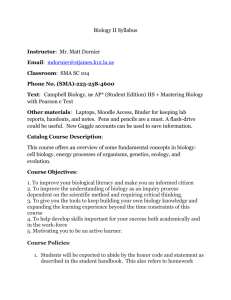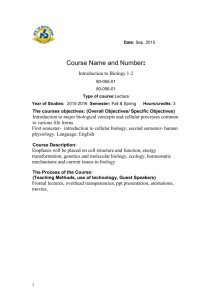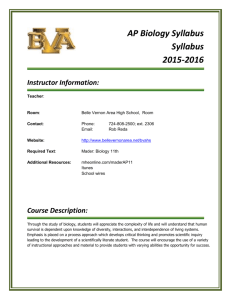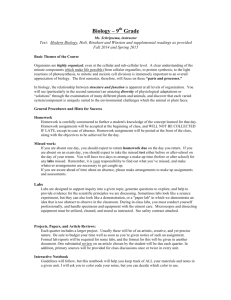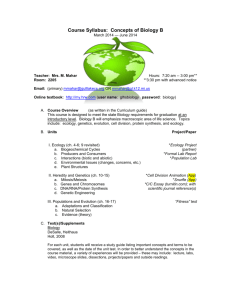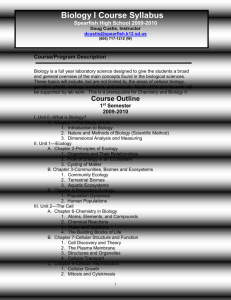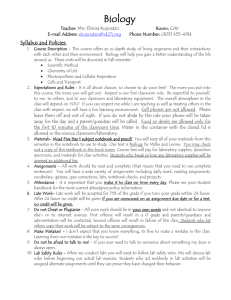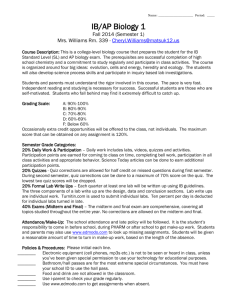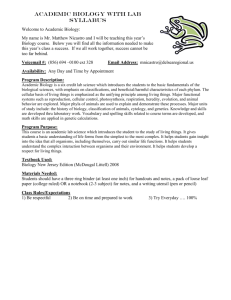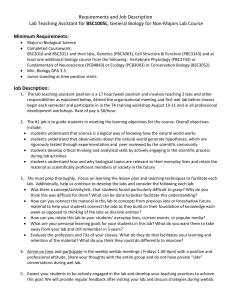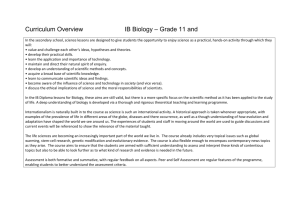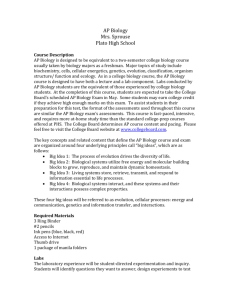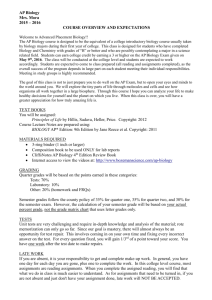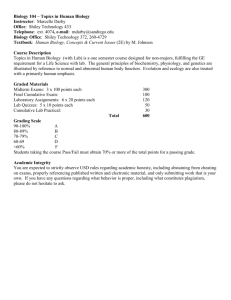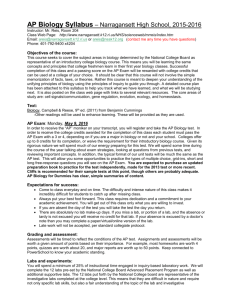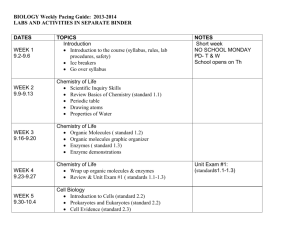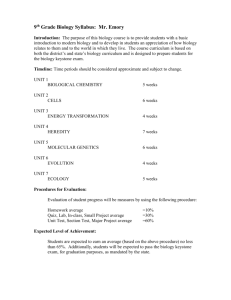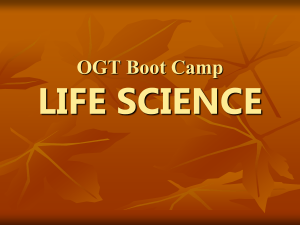ap biology syllabus - Moore Public Schools
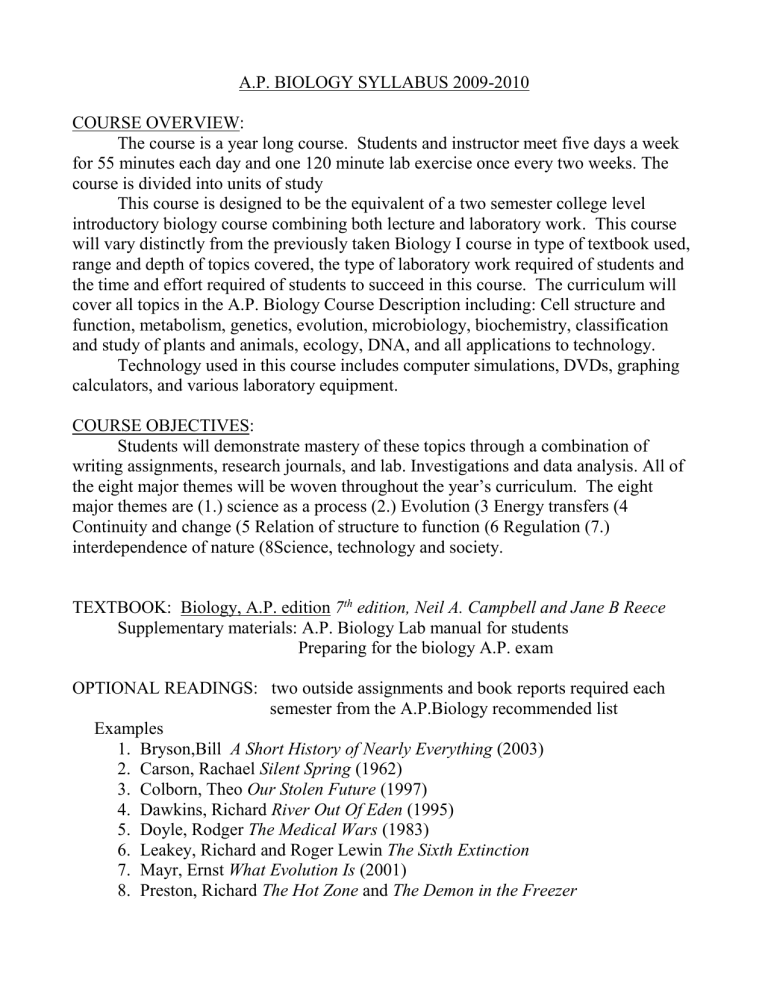
A.P. BIOLOGY SYLLABUS 2009-2010
COURSE OVERVIEW:
The course is a year long course. Students and instructor meet five days a week for 55 minutes each day and one 120 minute lab exercise once every two weeks. The course is divided into units of study
This course is designed to be the equivalent of a two semester college level introductory biology course combining both lecture and laboratory work. This course will vary distinctly from the previously taken Biology I course in type of textbook used, range and depth of topics covered, the type of laboratory work required of students and the time and effort required of students to succeed in this course. The curriculum will cover all topics in the A.P. Biology Course Description including: Cell structure and function, metabolism, genetics, evolution, microbiology, biochemistry, classification and study of plants and animals, ecology, DNA, and all applications to technology.
Technology used in this course includes computer simulations, DVDs, graphing calculators, and various laboratory equipment.
COURSE OBJECTIVES:
Students will demonstrate mastery of these topics through a combination of writing assignments, research journals, and lab. Investigations and data analysis. All of the eight major themes will be woven throughout the year’s curriculum. The eight major themes are (1.) science as a process (2.) Evolution (3 Energy transfers (4
Continuity and change (5 Relation of structure to function (6 Regulation (7.) interdependence of nature (8Science, technology and society.
TEXTBOOK: Biology, A.P. edition 7 th edition, Neil A. Campbell and Jane B Reece
Supplementary materials: A.P. Biology Lab manual for students
Preparing for the biology A.P. exam
OPTIONAL READINGS: two outside assignments and book reports required each
semester from the A.P.Biology recommended list
Examples
1.
Bryson,Bill A Short History of Nearly Everything (2003)
2.
Carson, Rachael Silent Spring (1962)
3.
Colborn, Theo Our Stolen Future (1997)
4.
Dawkins, Richard River Out Of Eden (1995)
5.
Doyle, Rodger The Medical Wars (1983)
6.
Leakey, Richard and Roger Lewin The Sixth Extinction
7.
Mayr, Ernst What Evolution Is (2001)
8.
Preston, Richard The Hot Zone and The Demon in the Freezer
SEMESTER ONE
Topics covered Chapters covered Time
UNIT ONE chemistry of life lecture topics covered include ch. 2-5 & 8 4 weeks
1.
composition of all matter-chemical basis of life
2.
the uniqueness of the water molecule
3.
organic chemistry-the carbon backbone
4.
macromolecules-proteins, lipids, carbohydrates, and nucleic acids
5.
structure of macromolecules
6.
enzymes and metabolism
A.P. Lab #1 diffusion and osmosis-Lab. Journal entry due
A.P. Lab # 2 Enzyme catalysis-lab. Journal entry due
____________________________________________________________________
UNIT TWO
Cells ch.6, 7, 11,12 &13 4 weeks
Lecture topics
1.
a review of cell organelles and structure
2.
comparison of eukaryotic and prokaryotic cells
3.
cellular membranes and types of transport
4.
the cell cycle
5.
compare and contrast mitosis and meiosis
A.P. Lab #3 Mitosis and Meiosis-Lab. Journal entry due
Class activity: examine, draw and label different types of cells under the microscope
UNIT THREE
Photosynthesis and Cellular Respiration ch.9 & 10
Lecture topics
1.
review the two stages of photosynthesis
2.
light energy converted to ATP
3.
importance of the Calvin cycle
4.
glycolysis and citric acid cycle
5.
compare and contrast these two cycles and how they interact
3 weeks
Unit three continued
A. P. Lab. # 4 plant pigments and photosynthesis-Lab. Journal entry due
A.P. Lab. # 5 Cell Respiration-Lab. Journal entry due
UNIT FOUR
Genetics ch. 14-21 & 27
Lecture topics include
1.
Mendelian genetics
2.
inheritance patterns
3.
DNA and RNA structure and function
4.
transcription and translation
5.
bacteria and viruses
A.P. Lab # 7 genetics of organisms-Lab. Journal entry due
7 weeks
A.P. Lab #8 molecular biology-Lab. journal entry due
Class activity-construct a human karyotype
Class activity- if time allows, students will work in groups of two or three to produce a powerpoint of a chosen genetic disease and its treatment( including the possibility of genetic engineering to cure the disease) and then present it to the class
WINTER BREAK-SEMESTER TWO
UNIT FIVE
Evolution ch. 22-25 4 weeks
Lecture topics include
1.
Darwin’s theory-historical background
2.
population genetics
3.
mechanics of variation
4.
natural selection
5.
speciation
6.
macroevolution vs. microevolution
7.
genomics, cladograms, classification, molecular clocks
Unit five continued-
A.P. lab #8 population genetics and evolution-Lab. Journal entry due
Class activity-DVD over Darwin and Galapagos and a written synopsis review to follow
UNIT SIX
Protists, plants and fungi ch. 28-31, 35-39
Lecture topics include:
1.
protists as the simplest eukaroytes
2.
evolution and diversity of plants
3.
plant structure
4.
plant responses
5.
fungi and their impact on ecosystems
A.P. Lab # 9 transpiration-Lab. Journal entry due
3 weeks
SPRING BREAK
(Begin review each week for A.P. test-last 15 minutes of class)
UNIT SEVEN
Invertebrates
Lecture includes: ch. 32-33
1.
history of animal evolution
2 weeks
2.
discussion of various body plans
3.
overview of major invertebrate phyla
Class activity-dissection of one or two invertebrate examples-crayfish and earthworm
A.P. Lab #12 Dissolved oxygen and aquatic productivity-Lab. Journal entry due
______________________________________________________________________
UNIT EIGHT
Vertebrates, and their
comparative anatomy ch. 34, 40-49 and physiology
Lecture includes:
1.
characteristics of vertebrates
2.
physiology of the chordate phylum
5 weeks
unit eight continued-
3. familiarization with the vertebrate classes
3.
development of the amniotes
5. overview of the mammalian body systems
6. how mammals achieve homeostasis
7. animal reproduction
8. throughout this study, students will witness the evolution of structural complexity from one phyla to another
A.P. Lab #10 physiology of the circulatory system-Lab journal entry due
A.P. Lab. # 11 Animal Behavior-Lab. Journal entry due
UNIT NINE
Ecology ch. 50-55
Lecture topics include:
1.
types of biomes
2.
ecosystem structure
2 weeks
Classroom activity; students must illustrate an assigned biome with a PowerPoint presentation
3.
population ecology
4.
conservation
STUDENT EVAULATION
Unit tests count for approximately 55% of the total grade. Multiple choice test reviews count for 25 %. Daily work such as powerpoint assignments, book reviews, lab journals and group work assignments count for 20% of the final grade for each semester.
A.P TEST
Students are encouraged but not required to take the A.P. Biology test.
If they choose not to take the test then they are required to do a research paper over cloning or genetic engineering instead. Because the requirements for the research paper are quite stringent, they usually opt for the test.
LAB COMPONENT
I have indicated where I include the 12 required labs from the A.P.Biology curriculum. In these labs, students work in groups of two to four and they usually take two class periods. One period to do the prelab work and one lab period to run the lab and collect the data. There will also be a follow up day to compare journal and worksheet entries and to discuss the findings of the students from each group. Students are required to maintain a journal of all labs. These labs will have a pre-lab requirement in which the student will write a hypothesis and formulate an experimental design.
After the lab has been concluded the students will write up a formal lab report with graphs, results discussion and conclusion. I also include small additional labs interspersed throughout the year. Some of these are student driven (ex. microscope labs and pond lab. for protist identification) and some are teacher demonstrations to illustrate key concepts.
